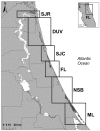Effects of study area size on home range estimates of common bottlenose dolphins Tursiops truncatus
- PMID: 29492031
- PMCID: PMC5804221
- DOI: 10.1093/cz/zox049
Effects of study area size on home range estimates of common bottlenose dolphins Tursiops truncatus
Abstract
Knowledge of an animal's home range is a crucial component in making informed management decisions. However, many home range studies are limited by study area size, and therefore may underestimate the size of the home range. In many cases, individuals have been shown to travel outside of the study area and utilize a larger area than estimated by the study design. In this study, data collected by multiple research groups studying bottlenose dolphins on the east coast of Florida were combined to determine how home range estimates increased with increasing study area size. Home range analyses utilized photo-identification data collected from 6 study areas throughout the St Johns River (SJR; Jacksonville, FL, USA) and adjacent waterways, extending a total of 253 km to the southern end of Mosquito Lagoon in the Indian River Lagoon Estuarine System. Univariate kernel density estimates (KDEs) were computed for individuals with 10 or more sightings (n = 20). Kernels were calculated for the primary study area (SJR) first, then additional kernels were calculated by combining the SJR and the next adjacent waterway; this continued in an additive fashion until all study areas were included. The 95% and 50% KDEs calculated for the SJR alone ranged from 21 to 35 km and 4 to 19 km, respectively. The 95% and 50% KDEs calculated for all combined study areas ranged from 116 to 217 km and 9 to 70 km, respectively. This study illustrates the degree to which home range may be underestimated by the use of limited study areas and demonstrates the benefits of conducting collaborative science.
Keywords: bottlenose dolphin; core area; home range; kernel analysis.
Figures





Similar articles
-
Abundance and demography of common bottlenose dolphins (Tursiops truncatus truncatus) in the Indian River Lagoon, Florida: A robust design capture-recapture analysis.PLoS One. 2021 Apr 28;16(4):e0250657. doi: 10.1371/journal.pone.0250657. eCollection 2021. PLoS One. 2021. PMID: 33909689 Free PMC article.
-
Home ranges of bottlenose dolphins (Tursiops truncatus) in the Indian River Lagoon, Florida: environmental correlates and implications for management strategies.Ecohealth. 2008 Sep;5(3):278-88. doi: 10.1007/s10393-008-0194-9. Epub 2008 Oct 8. Ecohealth. 2008. PMID: 18841416
-
Detection of cyanotoxins (microcystins/nodularins) in livers from estuarine and coastal bottlenose dolphins (Tursiops truncatus) from Northeast Florida.Harmful Algae. 2018 Jun;76:22-34. doi: 10.1016/j.hal.2018.04.011. Harmful Algae. 2018. PMID: 29887202
-
Atlantic Bottlenose Dolphins (Tursiops truncatus) as A Sentinel for Exposure to Mercury in Humans: Closing the Loop.Vet Sci. 2015 Nov 12;2(4):407-422. doi: 10.3390/vetsci2040407. Vet Sci. 2015. PMID: 29061950 Free PMC article. Review.
-
Health and Environmental Risk Assessment Project for bottlenose dolphins Tursiops truncatus from the southeastern USA. II. Environmental aspects.Dis Aquat Organ. 2017 Jul 24;125(2):155-166. doi: 10.3354/dao03143. Dis Aquat Organ. 2017. PMID: 28737160 Review.
Cited by
-
Abundance and demography of common bottlenose dolphins (Tursiops truncatus truncatus) in the Indian River Lagoon, Florida: A robust design capture-recapture analysis.PLoS One. 2021 Apr 28;16(4):e0250657. doi: 10.1371/journal.pone.0250657. eCollection 2021. PLoS One. 2021. PMID: 33909689 Free PMC article.
References
-
- Ballance LT, 1992. Habitat use patterns and ranges of the bottlenose dolphin in the Gulf of California, Mexico. Mar Mamm Sci 8:262–274.
-
- Balmer BC, Wells RS, Nowacek SM, Nowacek DP, Schwacke LH. et al., 2008. Seasonal abundance and distribution patterns of common bottlenose dolphins Tursiops truncates near St. Joseph Bay, Florida, USA. J. Cetacean Res Manage 10:157–167.
-
- Balmer BC, Wells RS, Schwacke LH, Schwacke JH, Danielson B. et al., 2014. Integrating multiple techniques to identify stock boundaries of common bottlenose dolphins Tursiops truncatus. Aquat Conserv Mar Freshw Ecosyst 24:511–521.
-
- Bas AA, Öztürk AA, Öztürk B, 2014. Selection of critical habitats for bottlenose dolphins Tursiops truncatus based on behavioral data, in relation to marine traffic in the Istanbul Strait, Turkey. Mar Mamm Sci31:979–997.
-
- Bejder L, Samuels A, Whitehead H, Gales N, Mann J. et al., 2006. Decline in relative abundance of bottlenose dolphins exposed to long-term disturbance. Conserv Biol 20:1791–1798. - PubMed
LinkOut - more resources
Full Text Sources
Other Literature Sources
